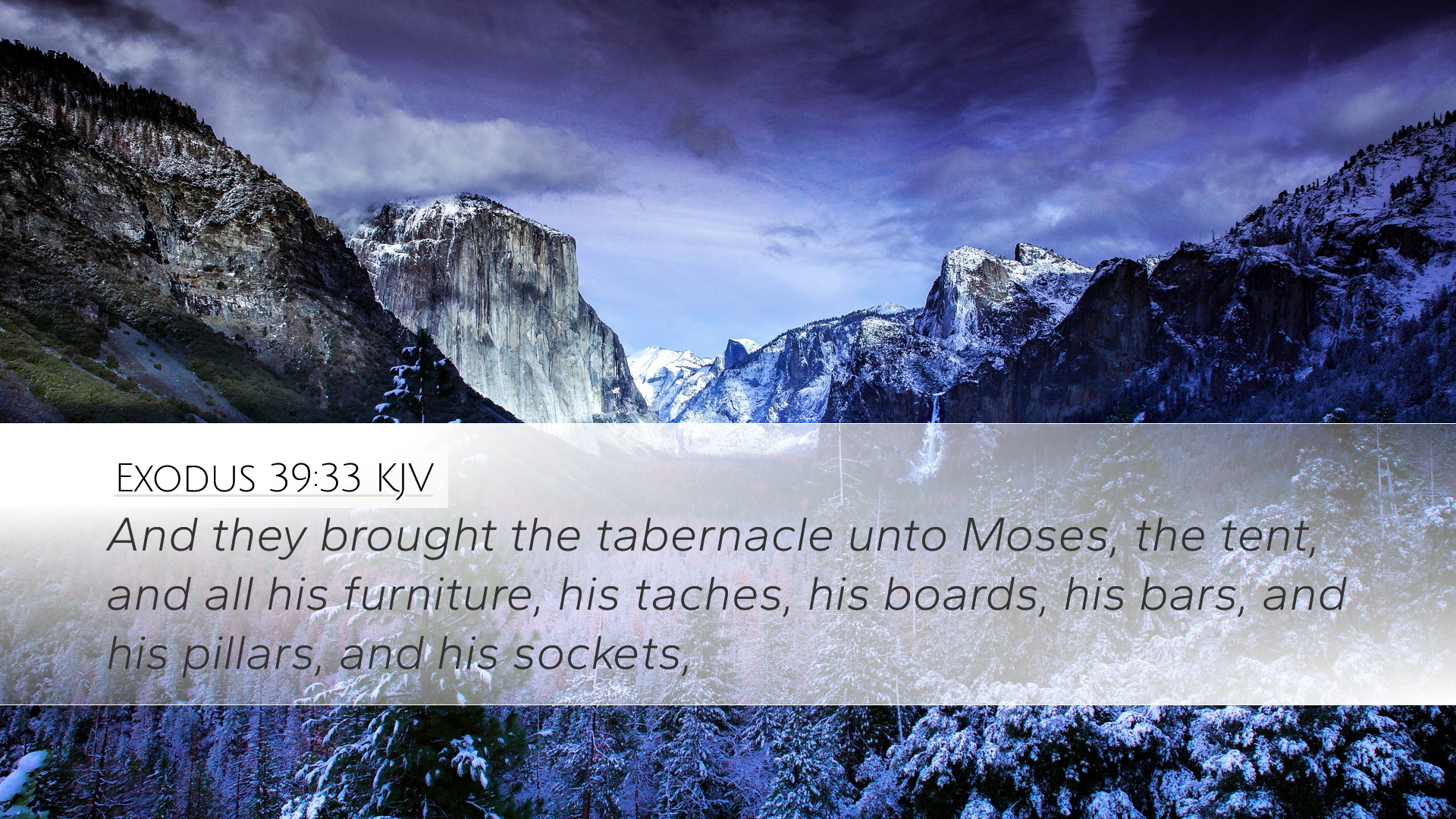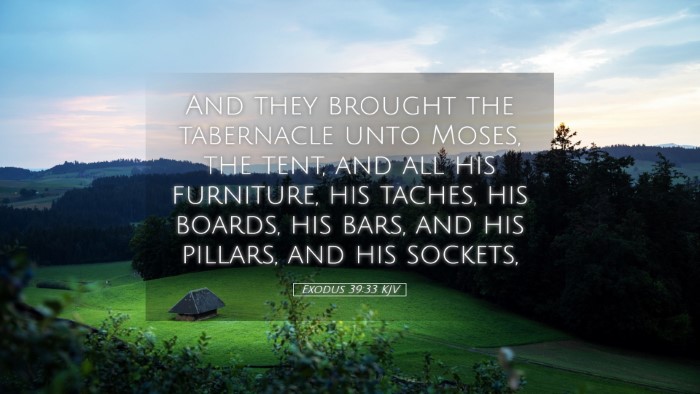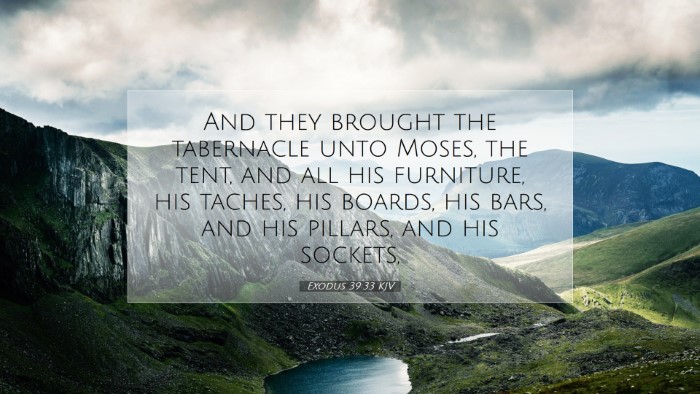Bible Commentary on Exodus 39:33
Verse: "And they brought the tabernacle unto Moses, the tent, and all his furniture, his taches, his boards, his bars, and his pillars, and his sockets." (Exodus 39:33)
Introduction
The verse provides a concluding statement about the construction of the Tabernacle, signifying a pivotal moment in Israel's journey towards establishing a worship identity. This commentary seeks to distill the rich insights from various public domain commentaries, highlighting theological implications, historical context, and practical applications for faith communities today.
Contextual Background
Exodus 39 is part of the extensive description of the Tabernacle's construction, which reflects God's intricate design and divine instruction provided to Moses on Mount Sinai. The Tabernacle served as the dwelling place of God among His people and a central place of worship.
The Significance of the Tabernacle
The construction of the Tabernacle was vital as it symbolized God’s presence among the Israelites. Matthew Henry notes that the Tabernacle "was the place where God would meet and commune with His people" (Henry, Commentary on the Whole Bible). This divine meeting signifies intimacy between God and His creation, highlighting God's desire to dwell among His people.
The Role of Moses
Moses' leadership role is underscored by his receipt of the Tabernacle, which denotes his responsibility in mediating between God and the people. Albert Barnes emphasizes Moses’ pivotal function: "Moses was the appointed mediator between God and Israel, and thus he represents the connection necessary for worship" (Barnes, Notes on the Old Testament). This aspect can be seen as a metaphor for Christ's ultimate mediation in the New Covenant.
Detailed Analysis of the Verse
- “Brought the tabernacle unto Moses”
This phrase reflects the communal effort in obedience to God's instructions for constructing the Tabernacle. Adam Clarke points out that the involvement of the entire community illustrates how sacred tasks require collective participation (Clarke, Commentary on the Holy Scriptures).
- “The tent, and all his furniture”
The mention of the tent and its furnishings points to both the physical aspects of worship and the spiritual realities they convey. Each piece of furniture—from the Ark of the Covenant to the lampstand—serves a purpose in Israel's relationship with God.
- “His taches, his boards, his bars”
These elements of the Tabernacle signify stability and security in worship. The detailed attention to construction materials suggests that God values both beauty and functionality in worship spaces, which can apply to today’s church environments.
- “His pillars, and his sockets”
The structural components symbolize the strength and foundation of God’s presence among His people. As Clarke posits, "the pillars represent support and protection, suggesting that God’s presence is a source of strength" (Clarke).
Theological Implications
The comprehensive gathering and presentation of the Tabernacle’s components underscore the significance of worship in the life of believers. The meticulous order indicates that worship is not haphazard but divinely orchestrated, reflecting divine order in creation.
God’s Holiness and Access
The Tabernacle serves to both manifest God’s holiness and provide a means for His people to approach Him. The various components serve to remind believers of the seriousness of approaching a holy God. Henry emphasizes the holiness of God reflected in the structure: "This is a call to worship done in a manner pleasing to God, acknowledging His majesty and our need for reconciliation" (Henry).
Community and Service
The construction of the Tabernacle was a communal endeavor. The collective effort reflects a community engaged in worship, emphasizing that worship is not an isolated experience but a shared journey. This aspect can be a powerful catalyst for contemporary church life, inspiring collective participation and service.
Practical Applications
Today, this scripture can serve as a reminder to pastors, theologians, and congregations alike about the importance of preparation and reverence in worship. Communities should reflect on how they build their own 'tabernacles'—places where God resides and is glorified among them.
Building 'Tabernacles' in Modern Worship
- Encouraging Intentional Worship: Churches should strive to create spaces that reflect God’s glory while providing a welcoming environment for all who seek Him.
- Fostering Community Involvement: Engage congregants in meaningful roles in church activities, highlighting the importance of community in worship.
- Creating Awareness of God’s Holiness: Encourage a greater understanding of worship that respects and acknowledges the holiness of God.
Conclusion
Exodus 39:33 encapsulates a critical moment in Israel's history, as the Tabernacle becomes a tangible symbol of God’s presence. The insights drawn from the commentaries reflect upon the importance of community, proper worship, and the divine desire for relationship. As believers deduce practical applications from this account, the overarching theme remains clear: worship is central to the life of faith, demanding our utmost reverence and collective effort.


